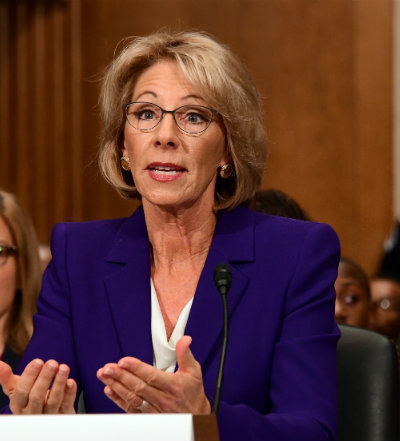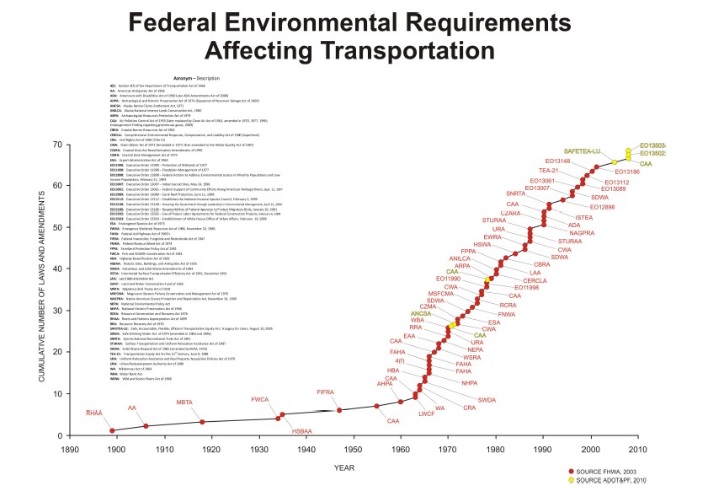Federalism in the Age of Trump
On education, health care, and infrastructure, the Trump administration and Republican Congress should free the states to do more.
Once Donald Trump takes the oath of office on Friday, Republicans will control all the levers of power in Washington, D.C., for the first time since 2006.
That does not mean there will be smooth sailing ahead for federal policymakers. Already, Trump and congressional Republicans determined to "repeal and replace" Obamacare have been stymied by the complexities of the health care law and the difficulty of fitting 330 million people into a single policy proposal. On infrastructure, Trump has promised a massive stimulus—as much as $1 trillion in new spending—but he's likely to face opposition from inside his own party, which spent most of the last eight years debunking the idea that federal deficit spending is good for the economy.
The appointment of Betsy DeVos, a champion for school choice and charter schools, as the next secretary of education is meant to indicate a clean break from the Obama administration on policy for schools, but there will be challenges on that front too. Unwinding federal education mandates like Common Core and No Child Left Behind are unlikely to be much easier than hacking away at the Affordable Care Act.
In place of major federal action to implement new policy, then, the new Republican-controlled government might want to take a page out of their pocket constitutions—the page with the Tenth Amendment printed on it. When the federal government struggles to find solutions, states can lead the way on these, and other, important issues.
The biggest policy debates facing America in 2017 will not be solved—or at least not solved best—by monolithic decision-making in the White House and the halls of Congress. Letting states sort out thorny issues provides other advantages too, like the fact that it is relatively easy for individuals and businesses to voluntarily exit from states that make poor policy choices.
To get a sense of how state governments can improve the prospects for liberty, both with and without help from the feds, Reason surveyed a group of wonks toiling to change policies in state capitals from coast to coast. This is what federalism in the age of Trump could look like.
Expanding Choice in Education

No Child Left Behind, the federal law that increased spending for schools in exchange for more testing to track student learning, turned 15 this month. It's old enough to be high school sophomore, but it's hasn't earned good grades.
By the end of the 2014 school year, 100 percent of all American students were supposed to meet the standards outlined by the Bush era law. Schools that failed to meet those goals were supposed to face consequences like restructuring.
Most of that hasn't happened. States lowered standards to make sure that more students could meet them and the Obama administration issued blanket waivers for the schools in states that adopted a new set of federal teaching guidelines called Common Core.
The problems with No Child Left Behind illustrate two of the biggest problems with the current status of public education. First, it was a one-size-fits-all solution that, second, funded education infrastructure—school buildings, administrators, and teachers—instead of funding students.
Yet the past decade-and-a-half has seen an upwelling of innovative education policy ideas from the state level, including expansions of charter schools, voucher programs, and education savings accounts. Many of those reforms have been focused on giving families a choice when it comes to public education, particularly for students trapped in failing schools for no reason other than their ZIP code.
DeVos, in her home state of Michigan, has a long history of fighting for those kinds of reforms. In 2000, she was heavily involved in an unsuccessful effort to remove the state constitution's ban on voucher programs via ballot initiative, and since then she has backed efforts to expand public charter schools there.
In her new federal post, she could help nudge states towards reform, says Ben DeGrow, director of education policy for the Michigan-based Mackinac Center.
That's where conservatives and libertarians find themselves walking a bit of a policy tightrope. Federal interventions, like No Child Left Behind, in state education policy has not worked, DeGrow says, but school choice activists should resist the urge to call for more federal action to implement policies they like.
At best, DeVos should work to peel back layers of federal regulation and encourage—not mandate—states to move in a direction that favors choice for parents and students. Of all the things on this list, this is the area where the greatest potential exists for the federal government to simply get out of the way and let the states experiment with new ideas.
"She can use the bully pulpit to make arguments for why students and parents should have choice and can really be a champion for that," DeGrow says.
Beyond making arguments, DeVos and the Republican Congress could enact small changes to a federal college savings program, allowing another state-level reform to take off in a big way.
"The vision for education that states and the federal government should pursue is really creating a modern education system where funds follow students where education is run like a market; driven by the decisions that parents make and students make."
Education Savings Accounts, or ESAs, were first created in Arizona in 2011 and the idea has already been duplicated by four other states. Across all five states there are more than 5,000 children using ESA accounts to pay for schooling.
Christina Sandefer, a vice president at the Phoenix, Arizona-based Goldwater Institute, a think tank that pioneered the ESA idea (and, fittingly, an organization named after a champion of states' right to determine their own policies without federal interference), says Congress and the Trump administration could expand access to education savings accounts by merely changing a few rules governing federal 529 college savings plans.
Those plans, which are technically run at the state level but authorized by the federal tax code, allow families to set aside money, tax-free, to cover the cost of higher education. They already function similarly to the ESA programs adopted by Arizona and other states, but federal rules prohibit the use of 529 funds for K-12 education.
"The Trump administration has a real opportunity to work with Congress to expand the use of these accounts to allow them to be used for preschool, to allow them to be used for more things in K-12, like tutoring and online education," Sandefur says. She argues that 529 accounts should be further tweaked to turn them into "lifelong learning accounts" that could be used for additional schooling and job training after college.
"If the federal government made some adjustments to these 529 accounts and allowed them to be merged with state education savings accounts, this would really move towards something revolutionary: a system where parents and students are in charge and they can tailor-make education that works best for them," she says.
Vouchers and education savings accounts function differently, but both adhere to the basic framework of letting education funding follow, and be directed by, students.
As with other policy areas on this list, the real key is returning decision-making power to the states when it comes to education. After decades of increasing federal direction—including the mostly disastrous No Child Left Behind law passed by the previous Republican administration—Republicans in D.C. should use the next two-to-four years to unwind the problematic federal mandates and one-size-fits-all solutions.
Some states will be unlikely to change course even with greater freedom, but others will follow Arizona's example or find other, new ways to address the needs of their populations.
"The vision for education that states and the federal government should pursue," says Sandefur, "is really creating a modern education system where funds follow students where education is run like a market; driven by the decisions that parents make and students make."
Embracing Health Care Competition

At a time when Democrats have only marginal power in Congress, the real battle over Obamacare is the "rift between state and federal GOP officials," declared Politico earlier this month.
While Trump and many Republican members of Congress won election by running against the Affordable Care Act, it turns out that lots of governors in red states are quite happy with the parts of Obamacare that direct federal Medicaid dollars to stressed state budgets. Add to the mix the fact the Trump seems to favor a single-payer healthcare system—pretty much the exact opposite of what Republicans in Congress have been floating as an alternative to the ACA—and you're left wondering if there's any realistic way for the GOP to thread that needle.
Few states have been more involved in the federal-state tug-of-war over the Affordable Care Act than Tennessee. It's one of the 19 states that refused to expanded Medicaid as was first ordered and then, following the Burwell Supreme Court decision in 2012, requested by the Obama administration. More recently, Tennessee was "ground zero" for the collapses of the Affordable Care Act's insurance exchange system, The Wall Street Journal declared in October when the state's insurance commissioner approved premium increases of 62 percent for plans on the state's federally-run health insurance exchange.
Like state policymakers everywhere, Justin Owen, president and CEO of the Nashville, Tennessee-based Beacon Center, a free market think tank, doesn't know what will come of Republican efforts to replace Obamacare.
He's hoping part of the solution will include Medicaid block grants to state governments. That would mirror the approach the federal government took in the early 1990s with welfare reform—handing "blocks" of money to the states and letting each set their own budgets.
"It really comes down to a question of whether you want your state to decide these things or have a one-size fits all approach from the federal government," says Owen.
Trump's pick to run the federal Department of Health and Human Services, Congressman Tom Price (R-Georgia), is an advocate of doing exactly that. Changing Medicaid to a block grant program would put states in charge of health insurance for their poorest residents and would potentially allow for cost savings as programs could be better tailored to the needs of each state's population.
"It really comes down to a question of whether you want your state to decide these things or have a one-size fits all approach from the federal government."
Still, it would be a fundamental change to the structure of Medicaid and would certainly face opposition from Democrats and progressive advocacy groups. The Center on Budget and Policy Priorities, one such group, warns that block granting Medicaid means "states would likely have no choice but to institute draconian cuts to eligibility, benefits, and provider payments."
Owen says states would benefit from increased budget flexibility in a block grant system. About one-third of Tennessee's annual budget is connected to Medicaid already. "Despite [Medicaid] being so central to our state budget, many of those decision are made in Washington and are out of our hands," he says.
Other changes at the federal level could increase competition and lower prices in some health care markets—by letting individuals buy insurance across state lines, for instance—but state lawmakers can get to work too. Health providers in many states are able to freeze out competition because of licensing rules known as Certificate of Necessity laws. Those CON laws, on the books in 36 states, give bureaucrats the final say before hospitals and other health care providers can buy new equipment, upgrade facilities, or offer new services.
At best, those laws only drive up prices or limit access to care, but at worst they can allow major providers to become cartels that capture regulatory boards and block medical innovations. "CON laws raise considerable competitive concerns and generally do not appear to have achieved their intended benefits for health care consumers," the Federal Trade Commission said in 2015, as part of a statement encouraging states to repeal these often anticompetitive measures.
Other state level reforms can help increase access to care by authorizing nurse practitioners, dental therapists, and other mid-level providers to do more hands-on work with patients. Some states have embraced licensing reforms to allow those providers to see more patients, though such changes have been met by stiff opposition from special interests like state-level trade associations for doctors and dentists.
Like with CON law reforms, the FTC encourages states to open up health care markets to more competition among providers, arguing that they can "increase the output of basic dental services, enhance competition, reduce costs, and expand access."
Finding Better Ways to Fund Transportation Infrastructure

But what about the roads?
During the campaign, Donald Trump promised a massive $1 trillion federal stimulus aimed at improving what he sees as sub-par American infrastructure.
Before getting into the details of what this might mean for the states, let's get a few obvious things out of the way: any stimulus is likely to be fraught with politically motivated spending decisions, bureaucratic waste, and will add billions of dollars to the deficit for limited short-term gains in employment. We know all this because it's been less than a full decade since the country's last experience with a federal stimulus (one that was at least partially justified, in some minds, by the recession). Trump's support for a stimulus is one of the best indications that he is unlikely to govern with an eye towards shrinking the size of government. Everything about this idea should be an anthemia to libertarians.
Politically, stimulus spending is supposed to create an immediate spike in employment to reflect positively on the current administration, but major infrastructure projects take years to plan and execute properly. The Trump administration should resist that urge and instead allow states determine how best to use a federal windfall. In some cases, that might mean sitting on the money for a few years while planning a major project, but that would be preferable to throwing billions of dollars at small-scale improvement projects—as the Obama stimulus did—that make work immediately but do little to improve infrastructure in the long term.
"I think we should look at this whole idea more skeptically," says Nathan Benefield, research director for the Harrisburg, Pennsylvania-based Commonwealth Foundation, a free market think tank.
State and local governments account for about three-quarters of all infrastructure spending in the United States, but state-by-state spending is all over the board, with some relying more heavily on the federal government's help and others doing most of the work locally. For obvious reasons, states are usually eager to have highway projects funded by the federal government, but subsidizing infrastructure can create imbalances between what is actually needed and what is built. Light rail projects, for example, are more likely to get federal funding if the price tag is larger—regardless of how useful the project might actually be.
"Given that transportation spending exists, states should aim to fund as much of it as possible from user fees and user taxes," says Joseph Henchman, vice president of state projects for the Tax Foundation, a Washington, D.C., based think tank that favors lower tax rates. "Subsidizing road spending from general revenues creates pressure to increase income or sales taxes, which can be unfair to non-users and undermine economic growth for the state as a whole."

It's not necessary to borrow $1 trillion to boost the nation's infrastructure. Simply getting some barriers out of the way would let current funding go farther. Chris Edwards, the director of tax policy studies for the libertarian Cato Institute, points to the fact that the number of environmental laws and executive orders creating barriers to transportation projects increased from 26 in 1970 to about 70 today. (Click here to expand chart on left)
The incoming Trump administration can spur infrastructure investment by working with Congress to repeal rules that unnecessarily delay projects and increase costs.
Getting rid of the Davis-Bacon Act—a New Deal era federal mandate that requires paying higher wages on any project where federal dollars are being used, even if most of the funding is coming from state or local governments—would similarly lower the cost of construction and let current infrastructure spending be more productive, Benefield says.
If the Trump administration is determined to unleash a torrent of infrastructure projects, those reforms would at least produce more bang for the buck.
The prospect of another federal stimulus also presents a number of potential pratfalls for state policymakers, including one that Pennsylvania learned about the hard way after the Obama stimulus.
When states do get their hands on stimulus cash, they should recognize it for what it is—a one-time thing. Pennsylvania used stimulus money in 2009 to increase subsidies for school districts, and many districts used that money to hire additional teachers or expand programs. Two years later, when the federal money disappeared, it left a gap in school budgets from Philadelphia to Pittsburgh.
"You saw that when the stimulus money runs out and states and school districts had been hiring people with it, then all of a sudden the state had to pick up the tab for those costs going forward," Benefield says.
Pennsylvania was hardly alone in making that mistake with the Obama stimulus—the $102 billion portion of the stimulus distributed by the Department of Education was similarly misused by Kansas, Ohio, Rhode Island, and others, despite warnings from then-Education Secretary Arne Duncan.
Trump says his stimulus program will work differently from Obama's and will focus solely on rebuilding infrastructure. Even if that's true, states would be wise to remember that one-time funding should be used exclusively for one-time expenses.




Show Comments (23)